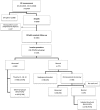Is there still a role for nuchal translucency measurement in the changing paradigm of first trimester screening?
- PMID: 31697852
- PMCID: PMC7027496
- DOI: 10.1002/pd.5590
Is there still a role for nuchal translucency measurement in the changing paradigm of first trimester screening?
Abstract
Objectives: To give an overview of the genetic and structural abnormalities occurring in fetuses with nuchal translucency (NT) measurement exceeding the 95th percentile at first-trimester screening and to investigate which of these abnormalities would be missed if cell-free fetal DNA (cfDNA) were used as a first-tier screening test for chromosomal abnormalities.
Methods: This is a national study including 1901 pregnancies with NT≥95th percentile referred to seven university hospitals in the Netherlands between 1 January 2010 and 1 January 2016. All cases with unknown pregnancy outcome were excluded. Results of detailed ultrasound examinations, karyotyping, genotyping, pregnancy and neonatal outcomes, investigation by a clinical geneticist and post-mortem investigations were collected.
Results: In total, 821 (43%) pregnancies had at least one abnormality. The rate of abnormalities was 21% for fetuses with NT between 95th and 99th percentile and 62% for fetuses with NT≥99th percentile. Prevalence of single-gene disorders, submicroscopic, chromosomal and structural abnormalities was 2%, 2%, 30% and 9%, respectively.
Conclusion: Although cfDNA is superior to the combined test, especially for the detection of trisomy 21, 34% of the congenital abnormalities occurring in fetuses with increased NT may remain undetected in the first trimester of pregnancy, unless cfDNA is used in combination with fetal sonographic assessment, including NT measurement.
© 2019 The Authors. Prenatal Diagnosis published by John Wiley & Sons Ltd.
Conflict of interest statement
All authors declare they have no conflicts of interest.
Figures
References
-
- Bilardo CM, Muller MA, Pajkrt E, Clur SA, Van Zalen MM, Bijlsma EK. Increased nuchal translucency thickness and normal karyotype: time for parental reassurance. Ultrasound Obstet Gynecol. 2007;30(1):11‐18. - PubMed
-
- Baer RJ, Norton ME, Shaw GM, et al. Risk of selected structural abnormalities in infants after increased nuchal translucency measurement. Am J Obstet Gynecol. 2014;211(6):675.e1‐675.e19. - PubMed
-
- Pilu G, Nicolaides K, Ximenes R JP: The 18‐23 week scan. https://fetalmedicine.org/var/uploads/18-23_Weeks_Scan.pdf [9 June 2018].
-
- The Fetal Medicine Foundation : Certificates of competence, Training and Certification. https://fetalmedicine.org/training-n-certification/certificates-of-compe... [12 June 2018].
MeSH terms
Supplementary concepts
LinkOut - more resources
Full Text Sources
Medical
Research Materials




